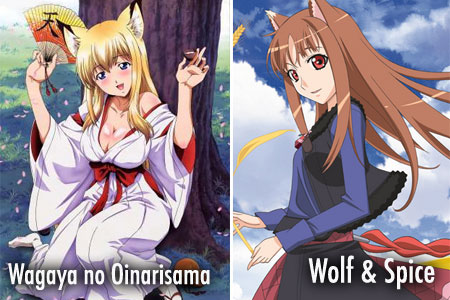Ask John: Why is Wolf & Spice More Popular Than Wagaya no Oinarisama?

Question:
Why hasn’t Wagaya no Oinarisama received as much notice as Spice & Wolf in the States?
Answer:
I can’t agree with the observation that the Okami to Koshinryo (Wolf & Spice) television anime from earlier this year has a significantly larger fan following among American anime fans than the current Wagaya no Oinarisama television anime. My own impression is that both series have a near equal, relatively minimal awareness and fan following in America. In my opinion, a larger American cult following for Okami to Koshinryo may be due to the fact that Okami to Koshinryo has concluded and been fully fan translated into English for American fans to appreciate while the more recent and still ongoing Wagaya no Oinarisama hasn’t had as much time to root itself in the minds of American otaku. However, I won’t argue with an observation that Okami to Koshinryo has generated greater interest among hardcore American otaku than Wagaya no Oinarisama.
2008 seems to be anime’s year of the wolf with Okami to Koshinryo, Kanokon, and Wagaya no Oinarisama all staring anthropomorphic female wolves or foxes. Kanokon has caused a bit of a stir among global anime fans because of its gratuitous sexuality. Serving as both a blessing and curse, Kanokon’s frank sexuality helped make the show highly enjoyable, but also caused countless American anime fans to reflexively dismiss the series. I think that a similar reaction has affected Wagaya no Oinarisama.
When development of the Okami to Koshinryo anime was initially announced in 2007, it was touted as a unique story that approached fantasy with the unusual perspective of concentrating on merchant relationships and financial dealings. Furthermore, the anime was introduced to Americans as an adaptation of Isuna Hasekura’s award winning novel series. So months before the anime even premiered, American fans expected it to be literate and unique. The majority of America’s anime fans, I think, aren’t especially inclined toward appreciating a relatively obscure, literate, romantic fantasy drama. However, I do think that America’s anime community has an instinctive, unconscious tendency to take note of anime that seem unconventional, intelligent, literate, or otherwise provide evidence that anime has more artistic credibility than mere children’s cartoons. In effect, Okami to Koshinryo may have generated some extra notice because it was promoted as serious art, unlike Wagaya no Oinarisama, which was introduced and promoted as merely another disposable pop culture anime.
The Wagaya no Oinarisama anime was introduced to America’s anime fan community after Ookami to Koshinryo. Although it was also based on a series of light novels, author Jin Shibamura’s novels seemed to be introduced to Americans as lightweight, disposable entertainment fiction. Furthermore, unlike the dramatic Okami to Koshinryo, Wagaya no Oinarisama is a more lighthearted domestic comedy – one that comes close to even becoming a dreaded cliche “harem” anime. So while Okami to Koshinryo was introduced to Americans as a title worthy of respect and anticipation, Wagaya no Oinarisama was introduced to America’s anime community as a series that doesn’t demand attention and respect.
Okami to Koshinryo was a fascinating series weakened by uneven pacing and not enough running time to satisfyingly develop its themes and various narrative threads. The ongoing Wagaya no Oinarisama is unquestionably a more lighthearted, less dense series, but in my opinion, it’s equally entertaining. I, personally, don’t perceive a significant disparity between the American fan community’s interest in Okami to Koshinryo and Wagaya no Oinarisama, but if the former does enjoy greater favor among American otaku, the reason may lie in unconscious and biased inclination rather than any significant gap between the quality of the two shows.

